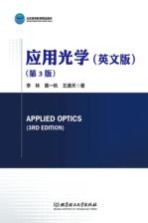图书介绍
应用光学 第3版 英文版pdf电子书版本下载

- 李林 著
- 出版社: 北京:北京理工大学出版社
- ISBN:9787568259217
- 出版时间:2018
- 标注页数:260页
- 文件大小:50MB
- 文件页数:269页
- 主题词:应用光学-英文
PDF下载
下载说明
应用光学 第3版 英文版PDF格式电子书版下载
下载的文件为RAR压缩包。需要使用解压软件进行解压得到PDF格式图书。建议使用BT下载工具Free Download Manager进行下载,简称FDM(免费,没有广告,支持多平台)。本站资源全部打包为BT种子。所以需要使用专业的BT下载软件进行下载。如 BitComet qBittorrent uTorrent等BT下载工具。迅雷目前由于本站不是热门资源。不推荐使用!后期资源热门了。安装了迅雷也可以迅雷进行下载!
(文件页数 要大于 标注页数,上中下等多册电子书除外)
注意:本站所有压缩包均有解压码: 点击下载压缩包解压工具
图书目录
Chapter 1 Basic Principles of Geometrical Optics 1
1.1 Waves and Rays 1
1.2 Basic Laws of Geometrical Optics 4
1.3 Refractive Index and Speed of Light 5
1.4 Reversibility of Ray Paths and Total Internal Reflection 6
1.5 Vector Form of Basic Laws 9
1.6 Classification of Optical Systems and Concept of Imaging 10
1.7 Ideal Images and Ideal Optical Systems 13
Chapter 2 Image Formation of Symmetrical Systems Made from Spherical Surfaces 17
2.1 Ray Tracing Formulae for Symmetrical Systems Made from Spherical Surfaces 17
2.2 Sign Conventions 19
2.3 Imaging Characters and Ray Tracing in the Paraxial Region 21
2.4 Basic Formulae of the Paraxial Region 23
2.5 Cardinal Points of an Optical System 26
2.6 Principal Planes and Focal Points of a Single Refracting Surface 29
2.7 Principal Planes and Focal Points of a Coaxial Spheric System 30
2.8 Chart Illustration for Image Formation 32
2.9 Image Positions and Sizes 34
2.10 Magnifications of Optical Systems 37
2.11 The Optical Invariant 40
2.12 Relationship Between the Front and Back Effective Focal Lengths 41
2.13 Nodal Planes and Nodal Points 43
2.14 Image Height of the Object at Infinity 45
2.15 Combination of Ideal Optical Systems 46
2.16 Ray Tracing for Ideal Optical Systems 49
2.17 Equations for Calculating the Positions of the Principal Planes and Focal Points of a Single Lens 52
Chapter 3 Instruments for Human Eyes 58
3.1 Characteristics of the Eye 58
3.2 Principles of the Magnifier and the Microscope 62
3.3 Principle of the Telescope 66
3.4 Defects of Eyes and Diopter Accommodation of Optical Instruments 69
3.5 Spatial Depth of Focus and Stereoscopic Effect 71
3.6 Binocular Instruments 73
Chapter 4 Mirror and Prism Systems 77
4.1 Applications of Mirror and Prism Systems in Optical Instruments 77
4.2 Imaging Properties of Mirrors 78
4.3 Rotation of Mirrors 80
4.4 Prism and Its Unfolding 81
4.5 Roof Surfaces and Roof Prisms 86
4.6 Imaging Properties of the Parallel Glass Block and Prism Size Calculation 88
4.7 Determination of Image Orientations for Mirrors and Prisms 92
4.8 Combination of the Coaxial System and the Mirror and Prism System 96
4.9 Prism Rotation Law 97
Chapter 5 Selection of Image Rays in Optical Systems 103
5.1 Stop and Its Application 103
5.2 Selection of Imaging Rays in Telescope Systems 104
5.3 Selection of Imaging Rays in the Microscope and Telecentric System 111
5.4 Field Lenses 115
5.5 Depth of Field 116
5.6 Cold Stop Efficiency of Infrared Optical System 119
Chapter 6 Basics of Radiometry and Photometry 122
6.1 Solid Angle and Its Applications in Photometry 122
6.2 Basic Ideas in Radiometry 123
6.3 Relative Sensitivity of the Eye to Different Wavelengths 125
6.4 Basic Ideas in Photometry 127
6.5 Illuminance Formula and the Cosine Law of Luminous Intensity 133
6.6 Luminance of the Perfect Diffusive Surface 135
6.7 Luminance of the Light Beam in Optical Systems 136
6.8 Illuminance of the Image Plane 139
6.9 Illuminance and F Number of the Image Plane of the Camera Lens 141
6.10 Subjective Brightness of Human Eyes 143
6.11 Subjective Brightness when We Observe Through a Telescope 145
6.12 Calculation of Light Energy Loss in Optical Systems 147
Chapter 7 Image Quality of Optical Systems 153
7.1 Introduction 153
7.2 Color Dispersion and Chromatic Aberrations 154
7.3 The Axial Monochromatic Aberration—Spherical Aberration 156
7.4 Off-axial Monochromatic Aberrations 158
7.5 Aberration Curves 164
7.6 Wavefront Aberrations 168
7.7 Resolutions of Ideal Systems 170
7.8 Resolutions of Typical Systems 172
7.9 Optical Transfer Function 174
7.10 Application of Optical Transfer Function 178
7.11 Spot Diagrams 181
7.12 Encircled Energy 183
7.13 A Typical Example of Imaging Quality Evaluation of an Optical System 184
Chapter 8 Telescopes and Microscopes 193
8.1 Optical Performances of Telescopes 193
8.2 Objectives of Telescopes 198
8.3 Eyepieces of Telescopes 204
8.4 Introduction of Microscopes and Their Properties 208
8.5 Objectives and Eyepieces of Microscopes 211
Chapter 9 Cameras and Projectors 215
9.1 Characteristics of the Camera Lens 215
9.2 Typical Camera Lenses 217
9.3 Typical Projectors 220
9.4 Illumination Systems in Projectors 221
9.5 Projector Lenses 223
9.6 Energy Calculation of Projectors 226
Chapter 10 Other Optical Systems 230
10.1 Laser Optical Systems 230
10.2 Optical Information Processing Systems and Fourier-transform Lenses 239
10.3 Infrared Optical Systems 242
Vocabulary 251
Bibliography 259